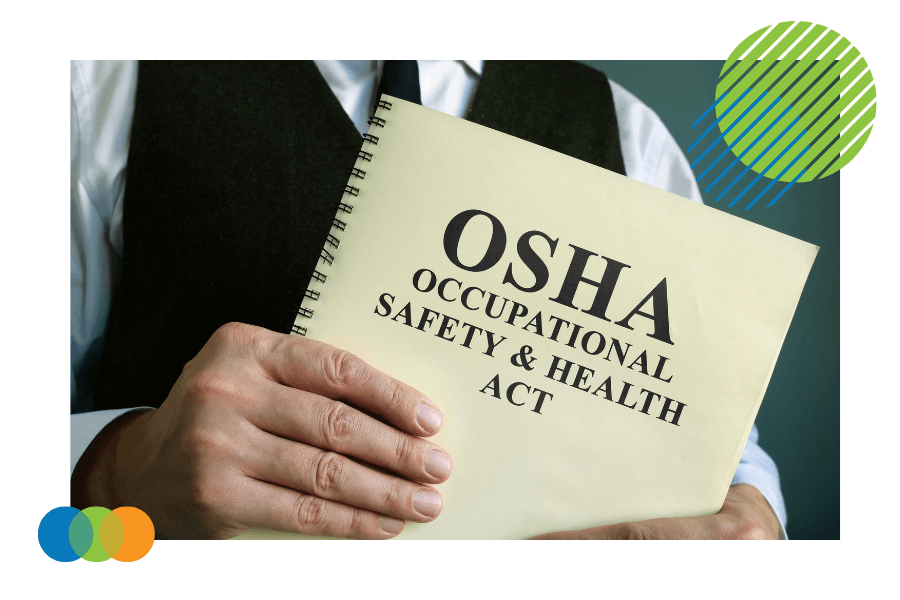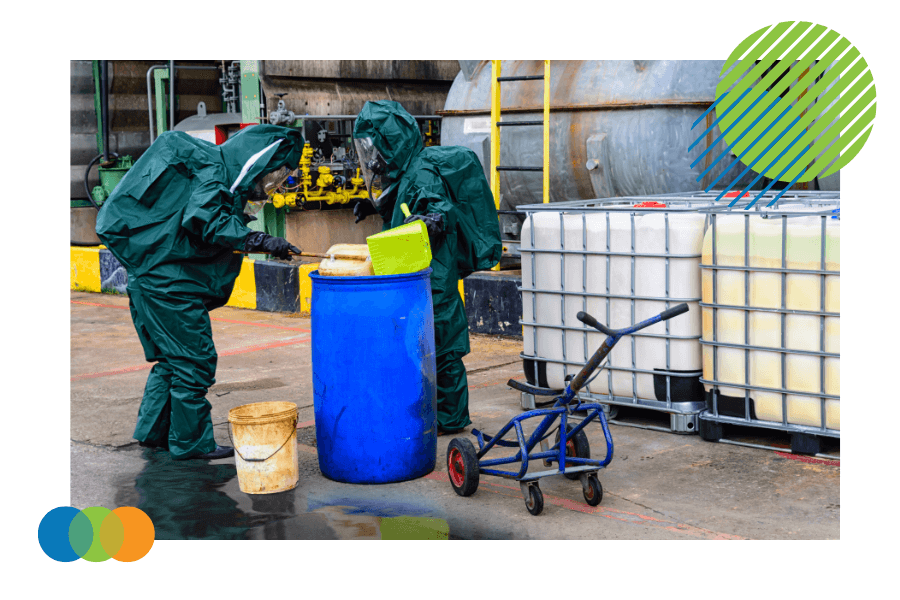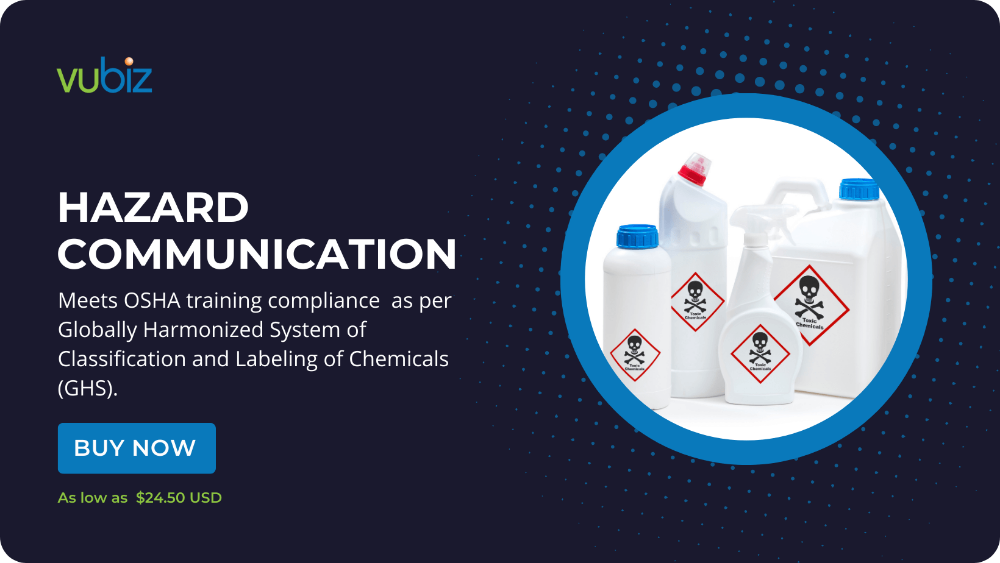 |
Written by Liz McDermott |

Estimates suggest that the U.S. employs more than 86,000 separate chemicals in various activities, from producing food to cleaning a kitchen. So, what steps can be taken to ensure the safety of staff and the workplace?
According to the Occupational Safety and Health Administration (OSHA), employers in the general industry must take specific steps to protect their employees from chemical hazards and toxic substances based on the amount of exposure they will have. Controlling the amount of occupational exposure is the most effective way to keep workers safe.
To assist employers in keeping their staff safe from harmful chemical hazards, toxic substances, and chemical risks, OSHA has created some useful regulations. This article takes a brief look at them.
What Regulations Does OSHA Place on Occupational Exposure to Hazardous Chemicals?
The Occupational Safety and Health Administration (OSHA) designates toxic substances and chemical hazards as any materials that can result in mild to severe health or physical issues. This pertains to all individuals, including those with allergies, who come in contact with any toxic substance or chemical hazard.
OSHA enforces the production and distribution of:
- Chemical importers and producers need to assess the potential risks of their products so they can generate labels and accompanying documents that contain the relevant hazard information.
- Companies with employees exposed to hazardous chemicals or toxins in the workplace must provide labels and data sheets that their personnel can comprehend.
- Employers are responsible for training workers to understand what is written on data sheets and labels and to implement measures to ensure their safety.
OSHA's Hazard Communication Standard (HCS) adopted the Globally Harmonized System of Classification and Labeling of Chemicals. This upgrade enabled a clear and consistent way to label and classify hazardous chemicals and materials and communicate relevant danger information.

What Are the Rules Set Forth by OSHA Concerning Permissible Levels of Airborne Substances?
Employers need to recognize and assess any respiratory hazards in the workplace. The level of occupational air exposure permitted for each substance depends on the magnitude of the risk, and OSHA's website provides the exact numbers.
The list of PELs can become complex quickly due to the varying explanations for the different levels. To make it worse, many need to be more accurate or updated.
When researching OSHA PELs, employers should consult annotated Z-Tables; however, this may be optional for other organizations.
The following entities define the permissible exposure limits for businesses:
- The Occupational Safety and Health Administration (OSHA) has approximated 500 Permissible Exposure Limits (PELs), most of which apply standard 8-hour time-weighted averages.
- Cal/OSHA, the Occupational Safety and Health Administration division in California, has the most thorough list of Permissible Exposure Limits (PELs) compared to other states with their own approved plans. This list is exclusive to California.
- The National Institute for Occupational Safety and Health (NIOSH) is a federal agency that offers Recommended Exposure Limits (RELs) and is seen as a reliable source of information for OSHA's Permissible Exposure Limits (PELs).
- The American Conference of Governmental Industrial Hygienists® (ACGIH®) provides Threshold Limit Values (TLVs®) and Biological Exposure Indices (BEIs®), which, while not intended to serve as legal standards, can offer guidance. This private, non-profit organization bases its PELs on health-related criteria.
When airborne exposure is extensive and engineering controls cannot be implemented, the company should supply respirators to the workers at no cost. It is essential to note that surgical masks will not be a substitute for respirators. Furthermore, employees must be trained to wear and remove the respirators given to them properly as part of the employer's Personal Protective Equipment (PPE) program.

What Is OSHA's Advice to Recognize Chemical Hazards and Toxic Substances?
Recognizing a hazardous chemical or toxin can be done by looking for several signs. These include any warning labels, strange odors, or any visible indications of contamination. It is essential to be aware of the potential risks associated with any unknown substance before coming into contact with it.
OSHA standards guide identifying the risks associated with hazardous chemicals used in a particular industry based on their intended purpose.
Apart from OSHA regulations, the OSHA website contains documents from other organizations, including the National Institute for Occupational Safety and Health (NIOSH), the U.S. Department of Health and Human Services, and the California Department of Public Health (CDPH).
The most advantageous details from the included documents are:
- The OSHA Laboratory Standard outlines what is deemed a chemical material in a laboratory. It also provides instructions on the correct utilization of lab equipment.
- The Report on Carcinogens focuses on substances identified as having cancer-causing capabilities.
- A vast array of reference material covering industry trends, control methods, and potential risks can be found in the NIOSH Numbered Publications: Criteria Documents.
- The NIOSH Pocket Guide to Chemical Hazards overviews essential hygiene information.
- The National Institute for Occupational Safety and Health (NIOSH) provides a comprehensive selection of Current Intelligence Bulletins, which cover a variety of health and other safety and health topics and issues, including those related to hazardous chemicals and toxins.
- An International Chemical Safety Card is a brief document summarizing health and safety information.
- The California Department of Public Health (CDPH) provides publications concerning the state's protocols for health and safety related to hazardous chemicals through its Hazard Evaluation System and Information Services.
The complexity of hazard recognition makes it impossible to put into a concise summary, so employers should research to find the safety data sheets that they need specific to the chemical they are working with.
What Are OSHA's Recommendations on How to Control Chemical Hazards and Toxic Substances?
Employers should adhere to OSHA guidelines to safeguard their staff from exposure to chemical hazards and toxic substances. Employers should work to create a safe working environment by implementing protective measures against the potential dangers of chemical exposure.
The hierarchy of controls is a tool that employers can use to decide how best to protect their workers from any exposure to hazardous chemicals. Elimination and substitution should be the first choice, while the least desirable option is using personal protective equipment (PPE), which is situated at the base of the pyramid of controls. The apex of the pyramid is the ideal solution.
Depending on the employer and where they are on the pyramid, employers should take the following steps:
- It is best to eliminate any chemical that is not necessary; if its use is required, it should be replaced with a safer substance.
- Physical Modifications. If the chemical can be handled less seriously, the workplace should modify its environment to decrease or remove the danger.
Controlling Administrative and Work Procedures
To guard against any further risk of harm, if the chemical remains hazardous even after alterations are made to the physical state, the workplace should devise strategies and guidelines to reduce contact with it, such as varying job roles or adjusting work timetables.
No matter the safety measures taken, if employee exposure to the chemical is deemed too hazardous, using PPE (personal protective equipment) is mandatory. This could include chemical-resistant clothing, gloves, eye protection, and respirators.
Employees should be aware of the potential risks they may face. If they are exposed to hazardous substances or chemicals, companies must take measures necessary to reduce the danger. If it is not feasible to eliminate the threat, then employers should supply proper protective gear.
Conclusion: Learning how to administer and control toxic substances and chemical hazards successfully is essential.
It is possible to reduce risks and ensure safety by monitoring the environment for contamination and taking proper precautions when handling hazardous chemicals and materials. Additionally, it is crucial to have a plan in place in an emergency. Knowledge of the properties and dangers of toxic chemicals is critical to manage them effectively.
Adherence to the standards set by OSHA is essential for employers to ensure the safety of their employees in the workplace. However, other institutions contribute to the Institute for Occupational Safety and create regulations to protect workers from exposure to chemical and hazardous materials. By following these rules, employers can foster a safe and pleasant workplace.
For more information, please contact us to inquire about our safety training programs.

